Crown Lengthening
Crown lengthening is a common procedure involved in the removal of gum tissue, bone or both to expose more of a tooth's structure.
What It's used for:
Crown lengthening is performed when a tooth needs to be restored, but there is not enough tooth structure above the gum line to support a filling or a crown. This often happens when a tooth breaks off at the gum line, or a crown or filling falls out of a tooth that has extensive decay underneath. In rare cases, a condition called gummy smile — when an unusually large amount of gum tissue shows around the upper teeth — can be treated using crown lengthening.
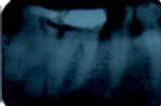
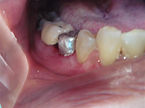
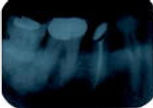
Before
After
Healing period
Cosmetic crown lengthening for "Gummy Smile."
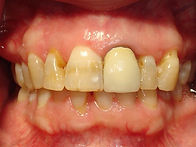
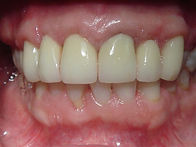
X-ray of crown lengthening results:
Preparation
During the initial consultation, Dr. Ross will review your medical history and your X-rays, and set a date for the surgery. You will be instructed on how to keep the area clean after the surgery. You may receive a tooth cleaning before the procedure. If the tooth needs a crown, a temporary crown may be put on the tooth to protect it. This also makes the crown-lengthening procedure easier because the tooth is already prepared for the crown, and the doctor can see precisely how much soft tissue or bone will need to be removed. Once the area has healed completely — in about three months — your general dentist will prepare the tooth again, and make a new temporary crown before making the final crown.
How It's Done
This procedure is done under local anesthesia. The amount of time it takes varies depending on the number of teeth that require treatment. Although your problem may involve only one tooth, crown-lengthening surgery typically includes neighboring teeth so that the tissues can be reshaped gradually. If only soft tissue is removed, the procedure probably will take less time than if both soft tissue and bone are removed.
Incisions are made to "flap" the gums away from the teeth. This provides access to the roots of the teeth and the surrounding bone. In some cases, by simply removing a little gum tissue when the incisions are made, enough tooth structure will be exposed for your dentist to place a crown of filling. However, in most situations it will also be necessary to remove some bone from around the roots of the teeth. The bone is removed using a combination of hand instrument and rotary instruments (similar to the drill and burs used to treat cavities).
Once enough tooth structure is exposed, the surgical area will be washed with sterile salt water and the flaps will be stitched together. At this point, your teeth will look longer because the gums are now sitting at a lower level then before the surgery. In most cases a periodontal dressing is used — called an intraoral bandage — to cover the surgical site.
Post-operatory Care Instructions
You will be given prescriptions for pain medication and a chlorhexidine mouth rinse. Your dentist will review oral-hygiene instructions, and ask you to follow a somewhat soft diet. You can brush the teeth in the area that was worked on, but you should avoid the gums. You can remove food particles around the affected teeth with a toothpick or a water irrigator.